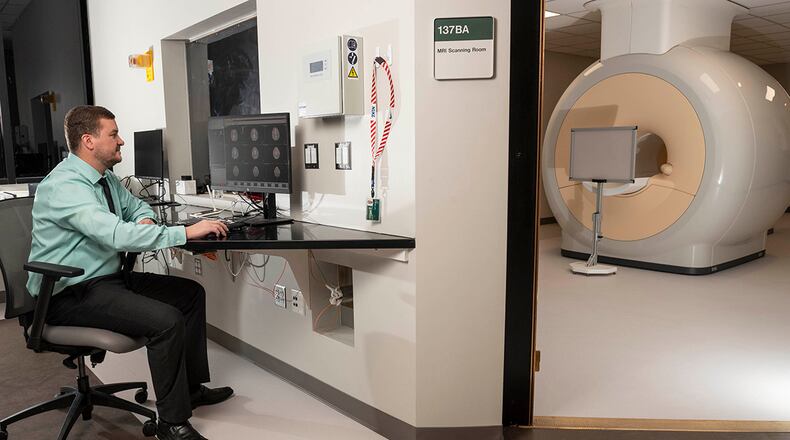The machine will boost regional research infrastructure, said Dr. Matthew Sherwood, director of Wright State’s Center of Neuroimaging and Neuro-Evaluation of Cognitive Technologies and a research professor in WSU’s Department of Neuroscience, Cell Biology and Physiology.
Some of the first evaluations and trial runs will start soon, and work with humans is slated to begin this summer, said Dr. Andy McKinley, a biomedical engineer and research lead in applied neuroscience for the Air Force Research Laboratory (AFRL) at Wright-Patterson Air Force Base.
Previously, Air Force researchers had been forced to rely on hospital MRIs on nights and weekends, “a tougher logistical challenge,” McKinley said.
The Wright State MRI will be a welcome change.
“This is something we’ve been wanting for quite a number of years,” McKinley said.
MRI uses strong magnetic fields and radio waves to create detailed images of organs and tissues within the body.
Researchers will employ the MRI in research on hypoxia, a condition in which the brain is deprived of oxygen. The condition can happen in high altitudes or underwater diving.
“We’re also interested in high G-forces and how that affects the brain,” Sherwood said in a Wright State release. “Is there a potential for neuro inflammation? Does it change how blood flows?”
This is some of the work that will bring Air Force scientists to Wright State’s Fairborn campus.
Dr. Claude Grigsby, the medical and operational biosciences core technical lead at AFRL’s 711th Human Performance Wing, said physically having the MRI in place at Wright State’s Neuroscience Engineering Collaboration building fulfills a longtime dream.
Research there will help answer questions on “brain-machine interfaces” and other emerging fields, Grigsby said. The possibilities stretch to new ways to control planes or “autonomous teammates,” and protecting the brain from stress and fatigue — keeping the warfighter in the fight longer.
“I don’t see the U.S. moving away from having a human in the loop, at least for certain key decision-making functions,” Grigsby said.
Wright State says Sherwood has already led nearly $3.5 million in Department of Defense-funded projects. Continuing work with researchers at Wright-Patterson is a distinct goal.
“We’re hoping they’re able to bring some of their research here,” he said. “We are committed to partnering with them.”
In a sense, the teamwork has already started. It took efforts by Wright State, AFRL’s 711th Human Performance Wing (based at Wright-Patterson), the Air Force Office of Scientific Research and Ohio government to put scanner on the Fairborn campus.
Credit: Erin Pence
Credit: Erin Pence
Getting the scanner required $1.32 million from the Air Force of Scientific Research’s Defense University Research Instrumentation Program, $200,000 from the state and $258,643 from Wright State.
The DOD provided a grant for the scanner in 2020, with the device arriving on Wright State’s Fairborn campus in March this year.
About the Author


